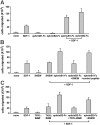EphB2 and EphB4 receptors forward signaling promotes SDF-1-induced endothelial cell chemotaxis and branching remodeling
- PMID: 16840724
- PMCID: PMC1895526
- DOI: 10.1182/blood-2006-05-023341
EphB2 and EphB4 receptors forward signaling promotes SDF-1-induced endothelial cell chemotaxis and branching remodeling
Abstract
The complex molecular mechanisms that drive endothelial cell movement and the formation of new vessels are poorly understood and require further investigation. Eph receptor tyrosine kinases and their membrane-anchored ephrin ligands regulate cell movements mostly by cell-cell contact, whereas the G-protein-coupled receptor CXCR4 and its unique SDF-1 chemokine ligand regulate cell movement mostly through soluble gradients. By using biochemical and functional approaches, we investigated how ephrinB and SDF-1 orchestrate endothelial cell movement and morphogenesis into capillary-like structures. We describe how endogenous EphB2 and EphB4 signaling are required for the formation of extracellular matrix-dependent capillary-like structures in primary human endothelial cells. We further demonstrate that EphB2 and EphB4 activation enhance SDF-1-induced signaling and chemotaxis that are also required for extracellular matrix-dependent endothelial cell clustering. These results support a model in which SDF-1 gradients first promote endothelial cell clustering and then EphB2 and EphB4 critically contribute to subsequent cell movement and alignment into cord-like structures. This study reveals a requirement for endogenous Eph signaling in endothelial cell morphogenic processes, uncovers a novel link between EphB forward signaling and SDF-1-induced signaling, and demonstrates a mechanism for cooperative regulation of endothelial cell movement.
Figures






References
-
- Pasquale EB. Eph receptor signalling casts a wide net on cell behaviour. Nat Rev Mol Cell Biol. 2005;6: 462-475. - PubMed
-
- Himanen JP, Chumley MJ, Lackmann M, et al. Repelling class discrimination: ephrin-A5 binds to and activates EphB2 receptor signaling. Nat Neurosci. 2004;7: 501-509. - PubMed
-
- Pasquale EB. Eph-ephrin promiscuity is now crystal clear. Nat Neurosci. 2004;7: 417-418. - PubMed
-
- Chrencik JE, Brooun A, Recht MI, et al. Structure and thermodynamic characterization of the EphB4/Ephrin-B2 antagonist peptide complex reveals the determinants for receptor specificity. Structure. 2006;14: 321-330. - PubMed
-
- Takemoto M, Fukuda T, Sonoda R, Murakami F, Tanaka H, Yamamoto N. Ephrin-B3-EphA4 interactions regulate the growth of specific thalamocortical axon populations in vitro. Eur J Neurosci. 2002;16: 1168-1172. - PubMed
Publication types
MeSH terms
Substances
Grants and funding
LinkOut - more resources
Full Text Sources
Other Literature Sources
Research Materials
Miscellaneous

